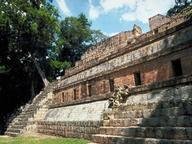Quiz Answer Key and Fun Facts
1. The problem with being an Egyptian royal was that grave robbers took a great interest in robbing your grave. The result was that it was not until 1922 that the untouched coffin of an obscure pharaoh was discovered in the Valley of the Kings near Luxor in Egypt by an archaeologist called Howard Carter. What was this pharaoh's name?
2. Sheltering from a storm in 1900, sponge divers discovered a wreck dating from the first century BC and recovered many artefacts including what has been described as the world's oldest analogue computer, the Antikythera mechanism. Where does the name for this come from?
3. Found in various caves at Qumran over the decade from 1946, these parchments proved to be highly significant to biblical scholars. Initially however the Bedouin shepherds who discovered the first few, didn't have much luck selling them. How are the Qumran Cave Scrolls better known?
4. Hierapolis (meaning 'holy city') was a Phrygian city in what is now Turkey and known for its hot springs. It also was the site of Pluto's Gate, an entrance to the underworld and shrine to the god. Contemporary writers recorded that bulls were offered as sacrifices during ceremonies at the shrine, which was known for its mephitic gases. How did the animals die?
5. Amateurs, although not always appreciated, have their place in archaeology. Marcelino Sanz de Sautuola owned the land where Altamira cave is and was looking for carved bones in the cave with an archaeology professor from the University of Madrid when his discovery was made. It was his eight-year-old daughter who actually found the bison paintings on the ceiling in 1878. Why were these significant?
6. Antibiotics are considered to be a modern phenomenon with the discovery of the first, penicillin, in 1929. However an important broad-spectrum antibiotic, tetracycline, has been found in Nubian mummies dating from 350 to 550 AD. A product of fermented grain, which of these foods provided the Nubians with their medicine?
7. Some archaeologists become focussed on finding their 'holy grail' (such as King Arthur's Camelot) to prove that legends describe real places and people. One such person was Heinrich Schliemann, who sought the legendary city of Troy. What is said to have inspired him?
8. The advent of aircraft revealed new man-made objects like the Nazca Lines in Peru. Another such discovery in the 1920s was of thousands of low walls in desert regions of Jordan, Egypt, Syria and Israel. Described as kites by the pilots who discovered them, they are typically laid out like two sides of a triangle, up to several kilometres long, with a small enclosure at its apex. What have archaeologists concluded they are?
9. There is a line to be drawn between fact and fantasy. While there are examples of legend turning out to be based on real events or places, some people try too hard to make the archaeological evidence fit their pet theory. An example was Piltdown Man, where fragments of the skull of an early humanoid were found in England during 1912. What was the problem with the skull?
10. Archaeology and mythology seem to have come together at Knossos. Associated with the myth of the Minotaur and the Labyrinth, this king's palace is believed to be at the archaeological site of Knossos, the largest Bronze Age settlement on Crete, seat of the Minoan civilisation and possibly Europe's oldest city. Who was the king?
Source: Author
suomy
This quiz was reviewed by FunTrivia editor
bloomsby before going online.
Any errors found in FunTrivia content are routinely corrected through our feedback system.

